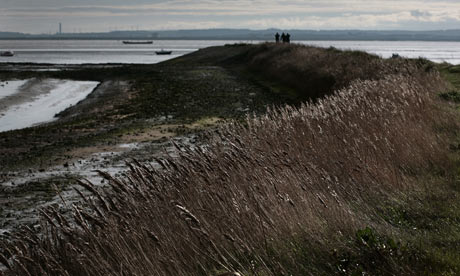Wildlife of the Thames estuary thrives - thanks to European protectors
http://www.guardian.co.uk/world/2012/jan/25/europa-wildlife-protection-london-gateway

Mudflats on the Thames close to the London Gateway development near Stanford-le-Hope, Essex. Photograph: Martin Godwin for the Guardian
Mucking Flats are aptly named: a strip of muddy shore along the north bank of the Thames river as it oozes into the estuary and out to sea. Even in low January sun, with the tide out, there are only a smattering of redshank on the shiny silt near the seawall, black-headed gulls idling on mud, and a line of black-tailed godwits and curlew silhouetted in the shallow river waters beyond.
Mucking flats are not pretty, but they are dramatic: shimmering with light and life – the plants, insects and reptiles which thrive in the rich soils in the salt marsh and abandoned industrial land attract birds in their thousands. It is an important migratory and breeding ground, protected by local and national laws as well as European directives. And when developers threatened the area with a new port and logistics park, ecologists were able to use EU rules to insist the wildlife remain protected.
Armed with the Wild Birds Directive ecologists were able to insist on changes to protect the birds' habitat and the often rare and protected species of insects and reptiles that live on the sandy shores behind. To compensate for a small area of Mucking Flats being used for the port and the great disturbance caused by building docks into the river itself, DP World of Dubai have had to relocate thousands of reptiles, newts and water voles, and started to recreate two areas of salt-marsh for birds and insects by taking away the seawall and flooding farmland that was growing peas three years ago.
While they do not always successfully fight off unwelcome development, the RSPB believes it would not have protected London Gateway and many other sites without the European rulings. "It means we can allow big, important economic developments – and of course small ones – and make sure we keep the special places," says Dave Hedges, the charity's area manager.
